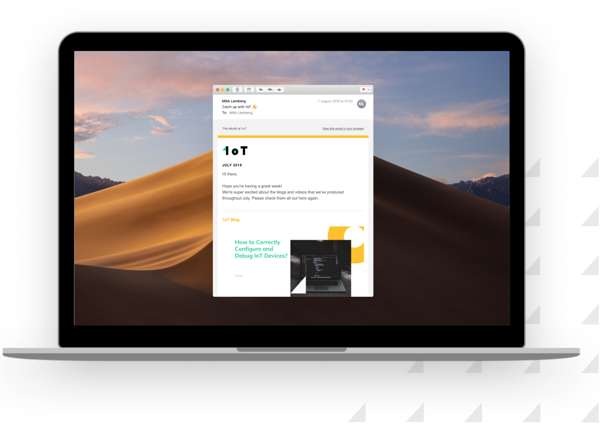The smart metering industry, covering residential, commercial and industrial solutions, is experiencing explosive growth. The market of monitoring utilities, including electricity, water, and gas, is estimated to be worth $19.98 billion by 2022 and $26 billion by 2026. According to the Globaldata Smart Meter report, 588 million smart meters will be installed by 2022. The trend is the result of an increase in IoT use cases, estimated to reach 20.4 billion devices by 2020.
Further adding to the sector's growth, the European Commission is aiming to replace 80 percent of electricity meters with smart meters within member states by 2020. These mandates, along with the trend of globalisation, where solutions are provided worldwide, means you never know where your device might end up and which connectivity provider the device would need. In addition, there are many challenges that smart metering faces that the eSIM (eUICC) specifically addresses.
Security challenges
Utility infrastructure is of critical importance when it comes to the maintenance of vital societal functions. With increased connectivity, these systems become high-value targets for cyber-attackers. Individual unprotected meters can also become an access point to the broader system if their security is undermined.
Smart meters without adequate security can be vulnerable to tampering by dishonest third parties attempting to make gains from energy theft. Malicious attacks can also impact the services of utility companies because they base their supply management on the smart meter data.
If smart meters are not protected and encrypted, their consumption data could be accessed by unauthorised entities. For example, they could identify or predict behaviors by gaining access to sensitive data such as when a household typically leaves or comes home and when they are away on vacation. To avoid this, robust connectivity is needed to provide for the confidentiality of data exchanged over the network.
Logistical Challenges
Connecting the smart meters to back-end servers may be achieved through many mediums, but cellular certainly has its advantages. Cellular technologies offer increased security, widespread coverage and quick implementation time differentiate it from non-cellular, less secure and relatively expensive solutions.
Another logistical challenge is related to the post-issuance change of subscription. As smart meters need to be deployed for 10-15 years and are often located in hard to reach locations, the servicing cost to replace subscriptions can be very high.
The solution…
Our aim is always to educate our readers, so now that we have covered the opportunity and discussed the related challenges, we want to share a plausible solution.
New and innovative solutions cannot rely on traditional solutions. While the world has changed since 1991, the SIM card has not – until the recent updates in eSIM technology. These new changes enable you to change profiles over the air without physically changing the SIM and hold multiple carrier profiles on the SIM at once. eSIM (eUICC) should not be confused with an embedded sim, as the latter is still locked to a single telecom provider. The unique functions of an eSIM also address several security and logistical challenges for smart meters.
Remote management and personalisation
The eSIM is great for deployments on a mass-market scale when you don't know where the product is going. After finding out the location, the appropriate carrier connectivity profile can be downloaded onto the SIM at the click of a button.
Also, after the device has been deployed, the eSIM technology is useful for remote management and personalisation. Smart meters are often dispersed or inaccessible and usually have a life cycle of 10-15 years. Future threats can also be mitigated through remote security updates and upgrades. The alternative of doing site visits each time something needs to be updated would be extremely complex with any other connectivity solution besides cellular. In fact, the high installation and ongoing management costs are identified as a critical factor that could hinder the growth of the smart metering market. Deploying eSIM has the potential to save millions in operating costs over the years.
Secure
The eUICC (eSIM) is a GSMA certified platform enabling universal authentication between networks. The new addition of remote management enables being ready to react to emerging security threats. This leads to lower cost and lower risk of security breaches in utility service networks.
Physical features
eSIM comes in the size of standard SIM cards (2/3/4FF) but can also be soldered (MFF2), enabling miniaturisation of the device that responds to consumers' expectations of convenience and minimal disruption. The eSIM's hardware is isolated from the rest of the module resources in the devices, protecting data and keys against hacking, tampering and unauthorised access.
Devices using eSIM can also be fitting for extreme conditions such as waterproofing because there is no need to access the physical SIM anymore. Also, in hazardous environments such as gas meters, the soldered eSIMs create no electrical currents, as is the case with traditionally removable SIM cards, therefore being much safer. Besides, the soldered sims are tamper-resistant, so they can't be stolen and used fraudulently.
Connectivity options
While boasting a wide range of different connectivity options (LTE-M, NB-IoT, LPWAN, 2G,3G,4G, and 5G), cellular users enjoy many advantages over other connectivity types. These include broader access across most inhabited areas, lower infrastructure costs, reduced installation costs and quicker set up times.
Cellular connectivity also has higher bandwidth compared to other wireless technologies and provides a universal approach thanks to the established SIM authentication. eSIM enables secure remote software updates for smart meters to update features or to provide new services, which would be extremely complex while using other network connections. The risk of security breaches and costs are further brought down with the established network authentication, which allows only authorised devices to connect to the utility device networks.
Global reach
The broadly spread cellular connectivity infrastructure gives its users wider coverage than, for example, WiFi. Using the existing cellular networks also means lower infrastructure costs, reduced installation costs and faster installation times.
Lessons from the automotive industry
The smart metering industry could learn from the more eSIM experienced automotive industry where car manufacturers such as Daimler, BMW, and Volkswagen have deployed eSIMs.
As cars have gotten smarter, cellular connectivity is a must. And to keep the connectivity costs under control the automotive industry has opted for eSIM, as the eSIM solves a multitude of logistical and security issues for the car manufacturers.
To make the most of eSIM, the car manufacturers have introduced their own carrier independent end-to-end solutions. Car manufacturers have invested in having their own dedicated SM-SR for all SIMs that are embedded in their cars and allowing multiple carriers to integrate their own SM-DP's with it. This has resulted in the car producers having independence from being locked-in to a specific operator.
Unfortunately, having your own SM-SR is too big of an investment that doesn't make sense for most companies or utility providers. So, the telecoms resistance to offer flexibility is one of the central factors why eSIM technology is not more widespread and used the way Daimler, BMW, and Volkswagen have set it up.
As a carrier independent service provider, 1oT offers you the freedom to choose the operator you want to use. We believe that you can't use the full potential of the eSIM for smart meters if you're locked-in with one operator. This allows the smart metering industry to access the eSIM technology that will enable the next generation of smart connected utility systems around the world.
In the end, everybody's free to decide if they want to deploy the SIM that has not changed for 20 years or the eSIM that enables new possibilities in the fifth technological revolution.
If you're interested in trying eSIM out for yourself then contact us.




